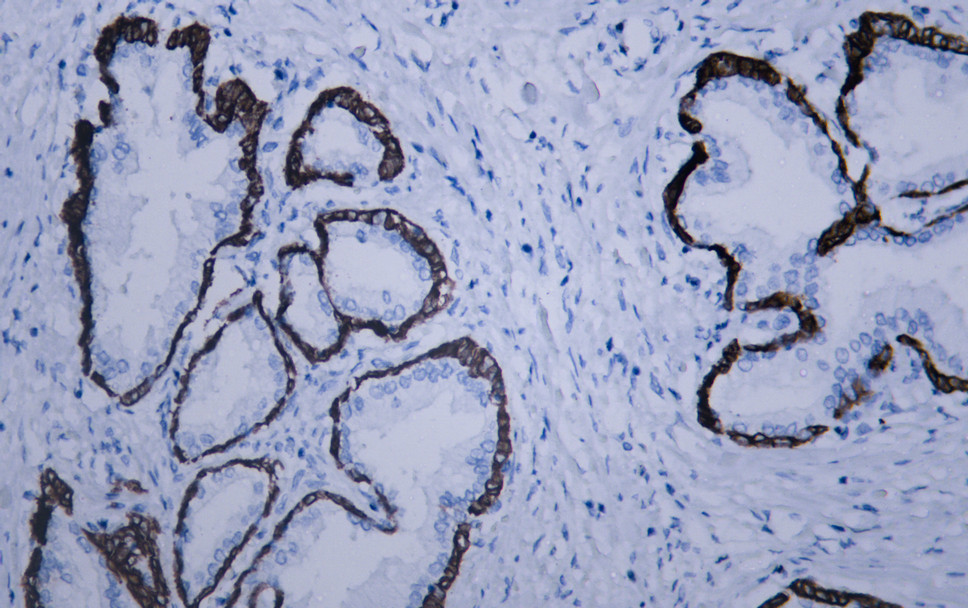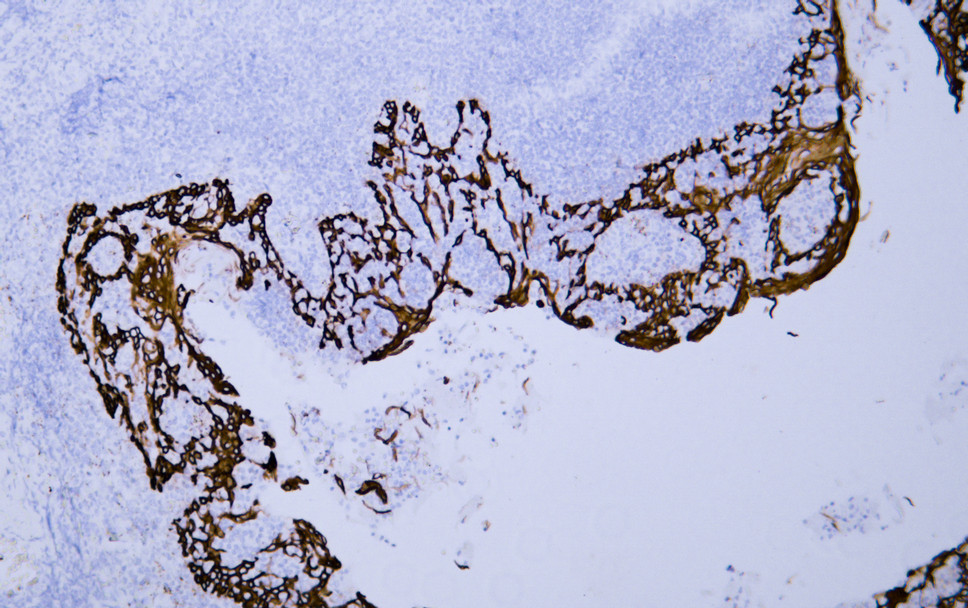Cytokeratin 14 (ABT047) Mouse mAb (Ready to Use)
- Catalog No.:YM4064R
- Applications:IHC
- Reactivity:Human;(predicted: Mouse; Rat)
- Target:
- Cytokeratin 14
- Fields:
- >>Estrogen signaling pathway;>>Staphylococcus aureus infection
- Gene Name:
- KRT14
- Protein Name:
- Cytokeratin-14
- Human Gene Id:
- 3861
- Human Swiss Prot No:
- P02533
- Immunogen:
- Synthesized peptide derived from human CK14 AA range: 400-472
- Specificity:
- The antibody can specifically recognize human CK14 protein. In immunohistochemistry on formalin-fixed, paraffin-embedded tissue sections, the antibody specifically labels the basal cell of squamous
- Formulation:
- Liquid in PBS containing 50% glycerol, 0.5% BSA and 0.02% sodium azide.
- Source:
- Monoclonal, Mouse IgG2b, Kappa
- Dilution:
- Ready to use for IHC
- Purification:
- The antibody was affinity-purified from mouse ascites by affinity-chromatography using specific immunogen.
- Storage Stability:
- 2°C to 8°C/1 year
- Other Name:
- Keratin, type I cytoskeletal 14 (Cytokeratin-14;CK-14;Keratin-14;K14)
- Background:
- This gene encodes a member of the keratin family, the most diverse group of intermediate filaments. This gene product, a type I keratin, is usually found as a heterotetramer with two keratin 5 molecules, a type II keratin. Together they form the cytoskeleton of epithelial cells. Mutations in the genes for these keratins are associated with epidermolysis bullosa simplex. At least one pseudogene has been identified at 17p12-p11. [provided by RefSeq, Jul 2008],
- Function:
- disease:Defects in KRT14 are a cause of epidermolysis bullosa simplex Dowling-Meara type (DM-EBS) [MIM:131760]. DM-EBS is a severe form of intraepidermal epidermolysis bullosa characterized by generalized herpetiform blistering, milia formation, dystrophic nails, and mucous membrane involvement.,disease:Defects in KRT14 are a cause of epidermolysis bullosa simplex Koebner type (K-EBS) [MIM:131900]. K-EBS is a form of intraepidermal epidermolysis bullosa characterized by generalized skin blistering. The phenotype is not fundamentally distinct from the Dowling-Meara type, althought it is less severe.,disease:Defects in KRT14 are a cause of epidermolysis bullosa simplex Weber-Cockayne type (WC-EBS) [MIM:131800]. WC-EBS is a form of intraepidermal epidermolysis bullosa characterized by blistering limited to palmar and plantar areas of the skin.,disease:Defects in KRT14 are the cause of derma
- Subcellular Location:
- Cytoplasmic, Membranous
- Expression:
- Expressed in the corneal epithelium (at protein level) (PubMed:26758872). Detected in the basal layer, lowered within the more apically located layers specifically in the stratum spinosum, stratum granulosum but is not detected in stratum corneum. Strongly expressed in the outer root sheath of anagen follicles but not in the germinative matrix, inner root sheath or hair (PubMed:9457912). Found in keratinocytes surrounding the club hair during telogen (PubMed:9457912).
- June 19-2018
- WESTERN IMMUNOBLOTTING PROTOCOL
- June 19-2018
- IMMUNOHISTOCHEMISTRY-PARAFFIN PROTOCOL
- June 19-2018
- IMMUNOFLUORESCENCE PROTOCOL
- September 08-2020
- FLOW-CYTOMEYRT-PROTOCOL
- May 20-2022
- Cell-Based ELISA│解您多样本WB检测之困扰
- July 13-2018
- CELL-BASED-ELISA-PROTOCOL-FOR-ACETYL-PROTEIN
- July 13-2018
- CELL-BASED-ELISA-PROTOCOL-FOR-PHOSPHO-PROTEIN
- July 13-2018
- Antibody-FAQs
- Products Images

- Human cervical squamous cell carcinoma tissue was stained with Anti-Cytokeratin 14 (ABT047) Antibody

- Human prostate tissue was stained with Anti-Cytokeratin 14 (ABT047) Antibody

- Human tonsil tissue was stained with Anti-Cytokeratin 14 (ABT047) Antibody



